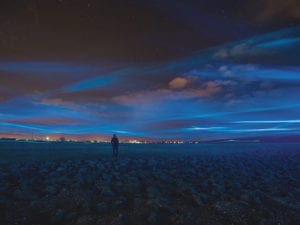Jason deCaires Taylor has spent the past decade studying the relationship between art and the environment, particularly how sculpture and science can combine to conserve the natural habitat. While many artists have moved outside to place their art in the countryside, in the middle of deserts or at the beach Taylor takes the movement much further – and a lot deeper. With the intention to force us to re-examine the sea, the British sculptor has most recently created an underwater museum, Museo Atlantico in Lanzarote.
Taylor was longlisted for the Aesthetica Art Prize in 2015 with his underwater installation Silent Revolution at MUSA (Museo Subacuático de Arte) in Mexico, which included 500 sculptures. Formed in the waters surrounding Cancun, this monumental installation makes up one of the largest and most ambitious underwater art attractions worldwide.
Born in 1974 to an English father and a Guyanese mother, Taylor developed an affinity for the sea from a very young age. Having spent much of his early childhood exploring coral reefs on the Malaysian coast, he later ran a dive outfit and became a fully qualified driving instructor and underwater naturalist. With a BA Honours from the London Institute of Arts in Sculpture, the self-starter sold his business to work in England while raising money to sink in the sea. In 2006, he then founded and created the world’s first underwater park, situated off the west coast of Grenada, West Indies, which is now listed as one of the Top 25 wonders of the world.
In his most recent fixed series he responds to the ongoing humanitarian crisis that has left millions of refugees seeking for shelter. Installed on the Atlantic Ocean floor beneath the clear blue waters off the coast of Lanzarote is Museo Atlantico, 14 metres deep. An assembly of 35 figures walks towards a gate – a point of no return or a portal to another world. In the installation The Raft of Lampedusa, 13 passengers on a sculpted boat serve as a reminder of our society’s passivity and our collectively responsibility to not just watch but act on the crisis. Open to divers and snorkelers, it is a major undersea museum in Europe.
As a contribution to the underwater environment, the site-specific, permanent works change over time with the effects of their surroundings. As reefs are shelter to about a fourth of all marine species, including fish lobsters, crabs, algae and coral, his installations are designed to act as artificial reefs and increase marine biomass whilst crucially diverting tourists away from the fragile natural reefs. Besides the demonstration of an interaction between art and environmental science, Taylor’s figurative work has become a powerful tool to raise political awareness and symbolise a symbiosis between man and nature, balancing messages of hope and loss.
To see more of Jason deCaires Taylor’s work, visit www.underwatersculpture.com
Entries are open for this year’s Aesthetica Art Prize: www.aestheticamagazine.com/artprize
Credits
1. Museo Atlantico, Jason deCaires Taylor, artist and photographer.





